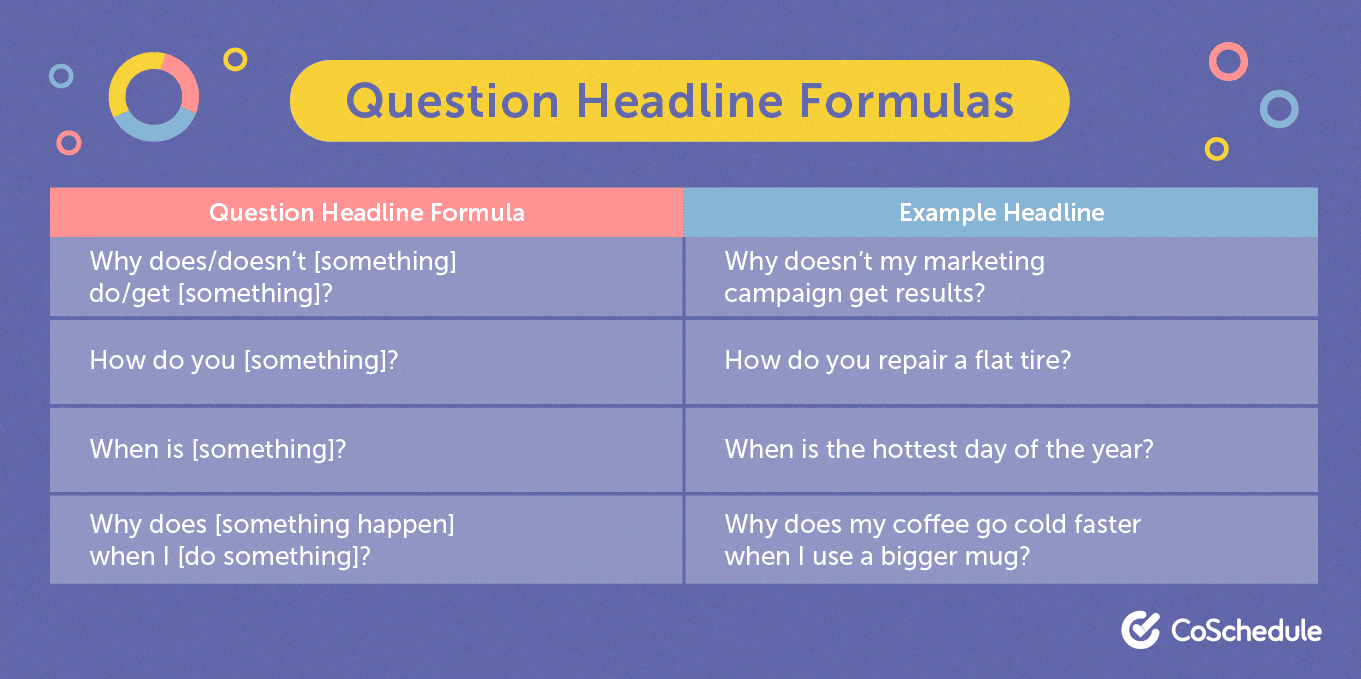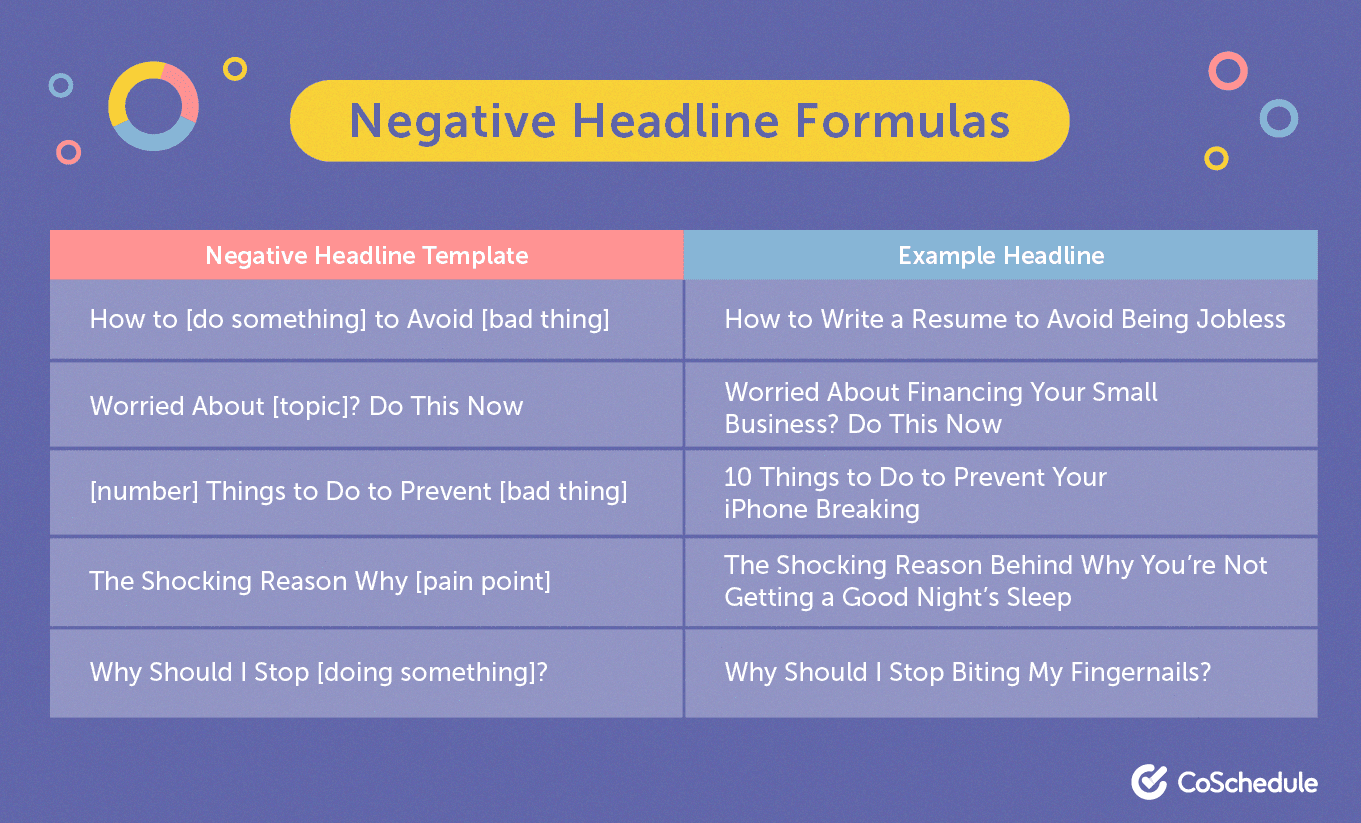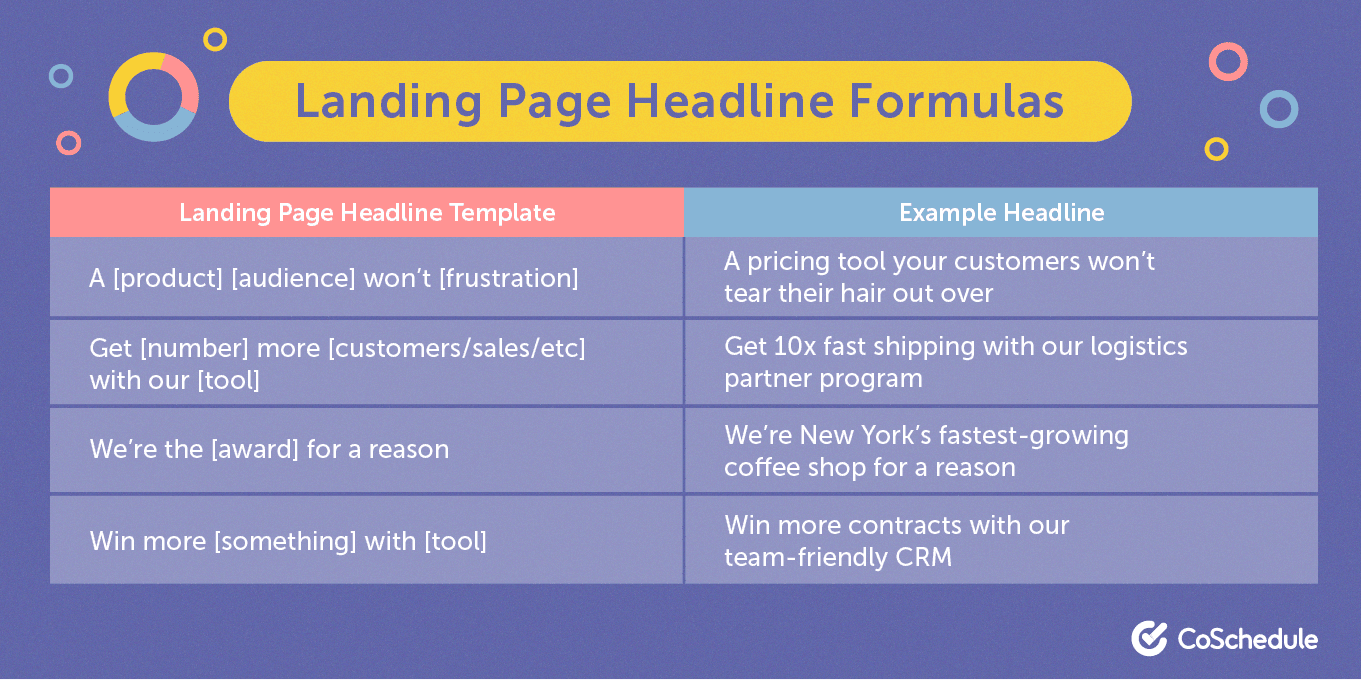It takes more than four hours to write the average blog post. Most of that goes into researching the structure, writing the copy, and finding relevant images to add in.
There’s something missing: your headline — the most important part of any type of content, period.
Marketers tend to glance over the headline because writing one is hard. They’re so important, and they can be so specific, that people avoid writing them. It can also take a decent chunk out of your four-hour average to work on the headline.
We compiled the ultimate list of 50+ headline formulas and templates, broken down by their format, to help you master headline writing.
Ready? Let’s dive in.
Download Your Headline Writing Template Bundle
Write better headlines with these three resources:
- Headline Writing Infographic: Packed with tips and advice on writing and A/B testing better headlines.
- Blog Title Performance Tracking Template: Track the results of headline A/B tests to narrow down which work best.
- Content Calendar Template: Once you have headlines written, plan every post and article you’ll write, all in one place.
Why are Headlines Important, Anyway?
You’re already using headlines in almost every type of marketing content you’re creating. That includes blog posts, social media posts, or advertisements.
They’re one of the most important parts of your content.
Why?
Generally speaking, a headline has one of these important goals:
- To get more clicks to the page.
- To get more people to see the content.
- To push someone down a page to continue reading.
Each three of those content marketing goals lead to a conversion. The more people who see, click, and engage with your content, the more likely they are to trust you.
That trust is essential to any type of conversion — especially purchasing.
Explore proven headline formulas and templates to craft Google Ads that grab attention—start building yours today!
54 Headline Formulas to Bookmark for Every Type of Content
We know that writing headline formulas is important.
That’s why we created the Headline Analyzer Studio — the most popular tool that marketers use to judge how good their headlines are.
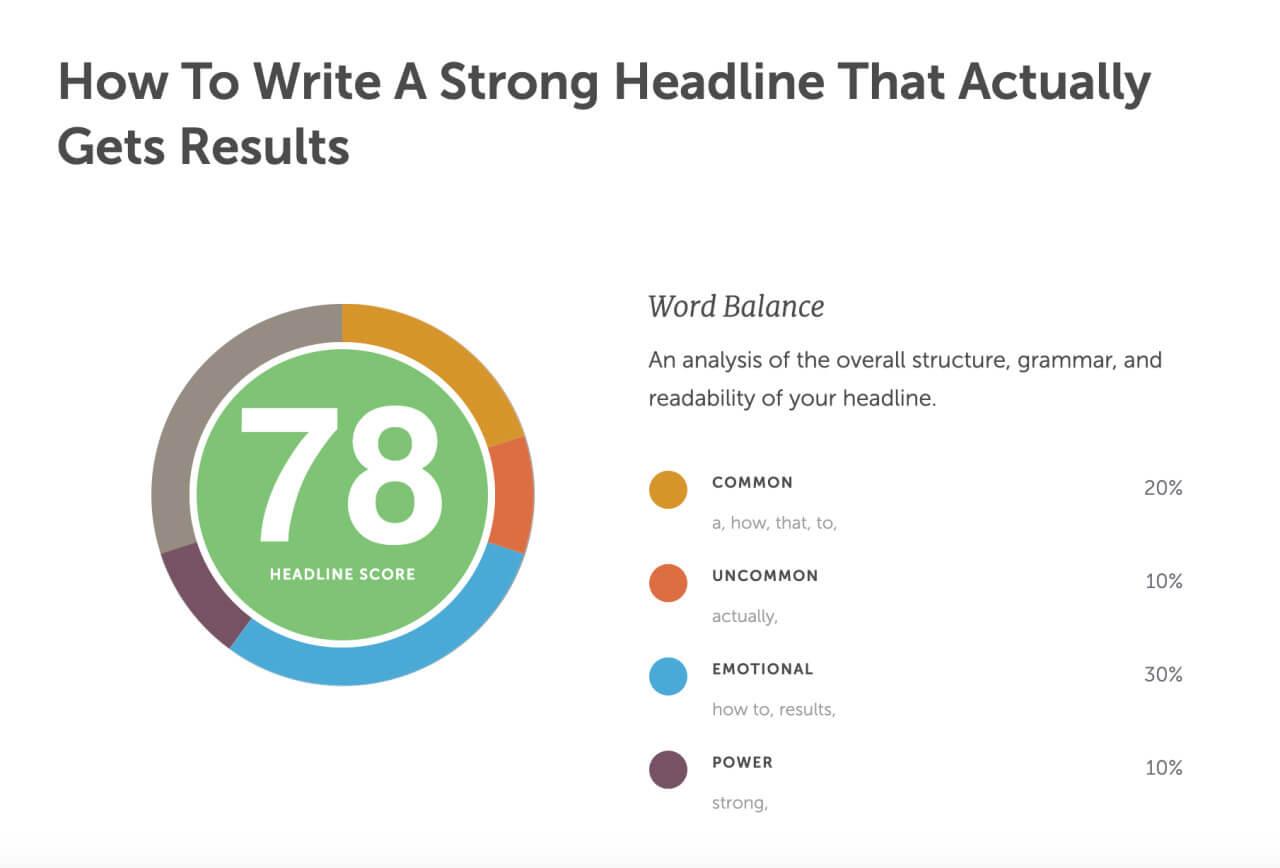
It’s easy to fall into the trap of recreating other headlines, but then yours isn’t unique. This completely defeats the point of a headline, which is to set you apart.
That’s why we’ve compiled the best headline formulas for every type of marketing content you’ll create. Each comes with a list of headline examples to show you the style in-action, along with several customizable templates you can tweak to start off strong.
Question Headline Formulas
One of the most popular headline formats is the question.
Research shows that 8% of Google search queries are questions. You can prove to Google and a searcher that your content answers their question by including it in your headline.
A question-based headline can come in two formats: something the reader is asking themselves, or something you’re asking to provoke a response. Regardless of which question you’re using, you’ll need to write something that shows you have the answer, if they click through.
Let’s take a look at some great question-based headlines and see why they’re effective:
- Why Does My Dog Eat Grass? It’s the exact search term I typed into Google. When I saw this pop up in my results, I clicked it. The headline was exactly what I was looking for, word-for-word.
- Egg Test: Boiled or Raw? This headline is still a question, but it has a fun prefix to make it more interesting. It doesn’t follow the keyword-exact heading like the one above, but it still works because it’s simple.
- Will Disney Make Frozen 3? This headline is intriguing and focuses around a popular topic. It also includes two phrases that people will look for when searching for the answer — “Disney” and “Frozen 3”.
- Are Marketing Degrees a Waste of Money? Instead of going with something flat, like “Should I Get a Marketing Degree?”, there’s a negative spin on the headline that relates to something nobody wants to do, like waste money.
- Is Homework a Waste of Students’ Time? Here’s another question-based headline with a slightly negative connotation. Nobody likes wasting time, but what’s great about this is that it’s balanced on an argument. Students who find that post will share it with their friends because nobody likes homework, right?
Statistic Headline Formulas
Got a list of statistics you want to round-up? Those posts are great for generating backlinks, but you need a great headline to make people want to read it in the first place.
Headlines for statistics-related posts are different from any other type of headline. They’re very specific, and usually focus around a specific topic. This headline format also tends to include numbers — including the date, to prove the statistics are relevant.
Here are five great statistic headline examples to draw inspiration from.
- 20+ (Actually New) B2B Content Marketing Statistics for 2020: When people are searching for statistics, they want to reference new studies. That’s why this headline includes the phrase “Actually New”. It promises to share up-to-date data for people frustrated with finding old statistics.
- 25 Eye-Popping Personal Finance Statistics About Saving Money & Debt: This headline example also has related terms included in there. It proves their content is uber-specific and makes sure people know exactly which statistics they’ll find inside.
- Nextiva’s State of Business Communication Report Reveals Pivotal Trends in 2020: This is an unusual heading format for a statistics round-up, but it works. Their brand name is included, which plays on their massive brand recognition. People already know and trust their brand; their statistics must be worth reading.
- Apple Sales Statistics: The Journey of the iPhone: Not every statistic headline needs a number included. This one, for example, has a more historical approach, rather than a math-heavy round-up. It appeals to people looking for information on one specific thing, rather than a collection of data around a bigger topic.
- The Marketing Management + Strategy Statistics You Need to Know in 2019: By implying that the reader needs to know them, there’s also a sense of urgency to click through. Nobody wants to be left behind, right?
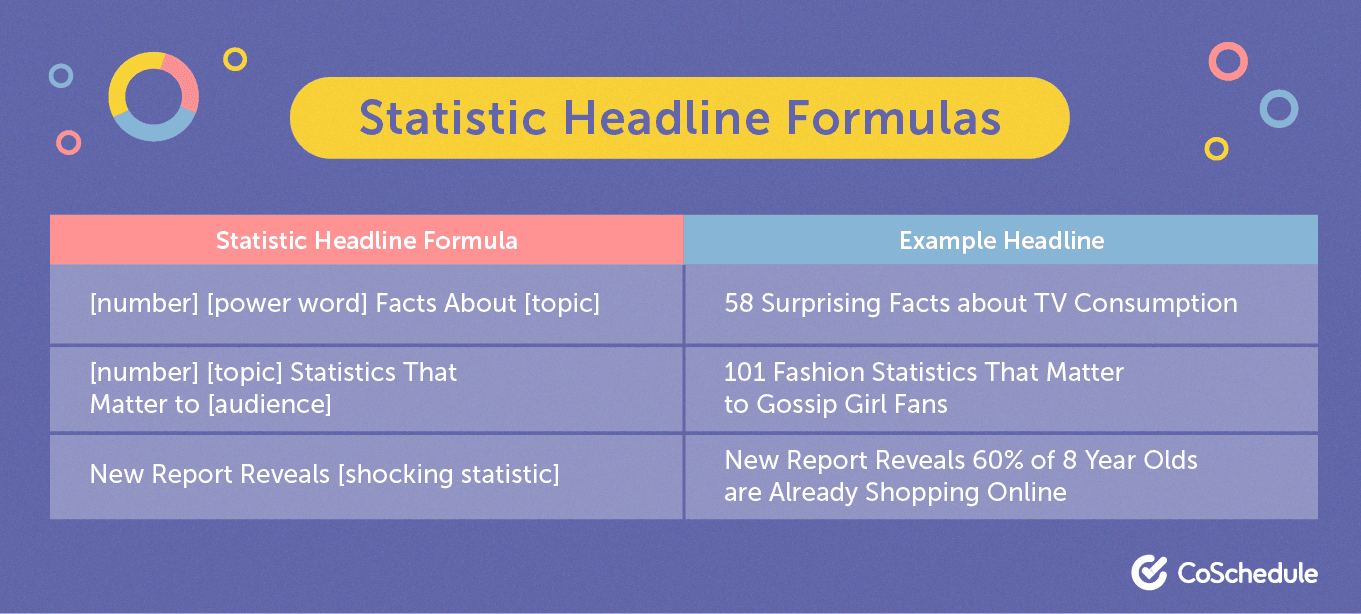
Curiosity Headline Formulas
Wanna Read a Blog Post That Will Change Your Life?
That right there is a curiosity headline. It doesn’t tell you exactly what the content talks about, but I’ll bet you want to click through if it promises to do something dramatic… like change your life.
Your goal with this type of headline is to pique someone’s interest, and get them to click through. You’re giving them a teaser; encouraging them to click-through to read more.
Let’s take a look at some of the best curiosity headline formats.
- 37 Facts You Never Knew About Harry Potter: Harry Potter has fans all over the world. It’s a common film that most kids watched growing up — often more than once. No matter how many times you watched it, you want to click this link to see what you missed.
- Anyone Can Teach Anything On This Education Site — And That’s Why It’s Worth Billions: This blog post doesn’t actually have anything directly to do with making money. It’s a review of an educational website (Udemy) that you can teach things on, but instead of going with something boring, like “How to Use Udemy,” they’ve left the brand name a secret. You want to click through to find out what it is.
- Want a Happy Marriage? Science Says Look for These Personality Traits in Your Spouse: This is a combination of different headline formats. It starts with a question the ideal reader wants to answer with a “yes,” and follows with something curious. You don’t get the answer from the headline alone; it encourages you to click it to find out.
- 10 Things No One Tells You About Solo Travel: This headline follows a similar style to the above. It implies that everyone knows about something except you. It plays to the psychological phenomenon of missing out — something of which 69% of millennials have a fear.
- Everyone We Know Owns a Pair of These Cult Sneakers: The fashion industry can feel very exclusive. The entire sector revolves around trends that people set and others follow. This example shows that in its most obvious form. They’re a big fashion brand who says “everyone they know” owns a pair of these shoes, but we have to click through to find out what they are.
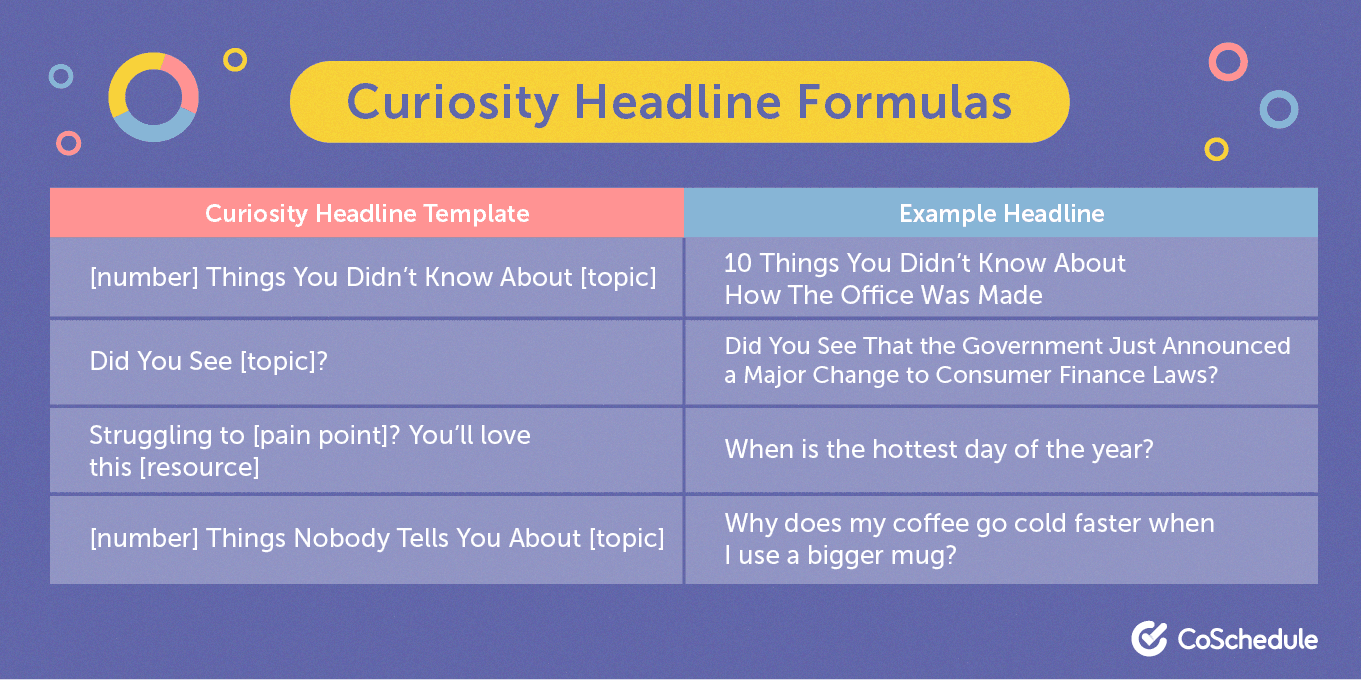
How-to Headline Formulas
The “how-to” format is one of the most popular types of content. It guides people through a specific thing, demonstrating or explaining how to do something they’re struggling with, step-by-step.
However, your headlines for how-to content don’t have to be boring — like “How to Change a Tire”.
Take a look at these how-to headline examples for ideas on how to jazz yours up.
- How to Make a YouTube Video (Beginner’s Guide): Some tutorials can be complex in nature. This headline, though, shows that you don’t need any existing knowledge to go through their tutorial. The “beginner’s guide” add-on makes their ideal reader — someone who doesn’t have a clue how to create YouTube videos — resonate with it.
- How to Use Quizzes to Start Building an Email List (With No Stress): Another great way to write a how-to headline is to reference a pain-point that other tutorials might not solve. This one, for example, implies that building an email list is stressful, but with their content, the stress is gone.
- How to Use Zoom: 10 Tips and Tricks For Better Video Meetings: This headline is a how-to format as the basis, but ties a listicle-style tagline towards the end. This works because you get the keywords “How to Use Zoom,” while also making it clear that the content is easy to digest.
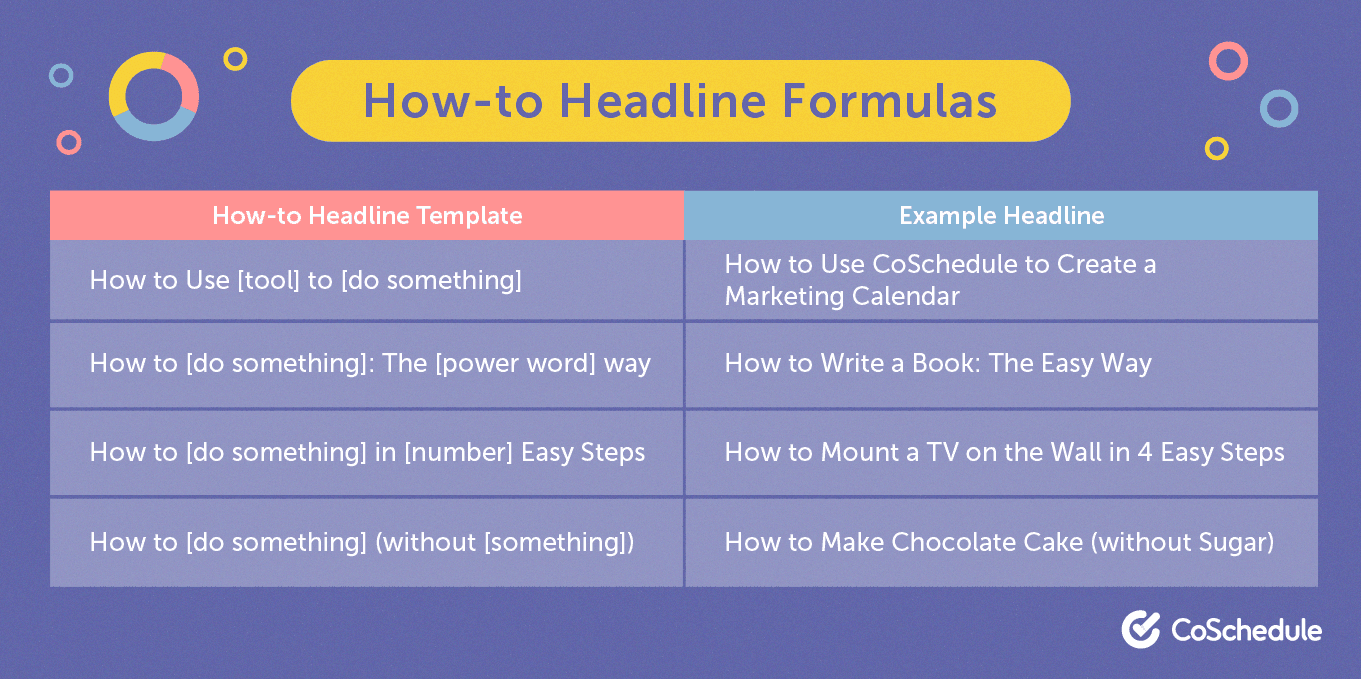
Recommended reading:
- Stay Ahead Of The Curve: The Best YouTube SEO Tools For 2024
- Grow Your Channel With Impressive Youtube Title Copy
Versus Headline Formulas
This type of content compares multiple features, brands, or items against each other.
It’s a superb content format, if your customers typically compare you or your products to a competitor. The headline is there to convince them to click through. Then, it’s your content’s job to show them that you’re the best option.
Let’s take a look at some real versus-style headline examples.
- Diastole vs. Systole: A Guide to Blood Pressure: This comparison headline has the two items they’re comparing at the beginning. However, it also adds slightly more information with the “Guide to Blood Pressure”. This helps people confirm they’ll find out the health-related information they’re looking for.
- Visa vs. Mastercard vs. American Express — Which is Best? Here’s another versus headline that compares three different banks. It has a “vs.” between each brand name, with a question at the end. It gets people thinking when they see it, and they’re using a power word — ”best”. It implies that you want to know which is best, but you’ll have to click through to find out.
- SEO Tools Showdown: SEMrush vs. Ahrefs vs. Moz Pro vs. SpyFu This is very similar to the headline above, but the order is switched round. It leads with “SEO Tools Showdown,” which grabs your attention right away. It also stands a chance at ranking for more related keywords, such as “SEO Tool Comparisons,” with that phrase at the beginning.
- Why Go With Drift vs. Intercom?: Most of the examples we’ve shared so far are unbiased in the headline. However, this comparison post clearly states that Drift is better than Intercom. It gives a unique angle and promises to explain why Drift is better — rather than inviting readers to make up their own mind.
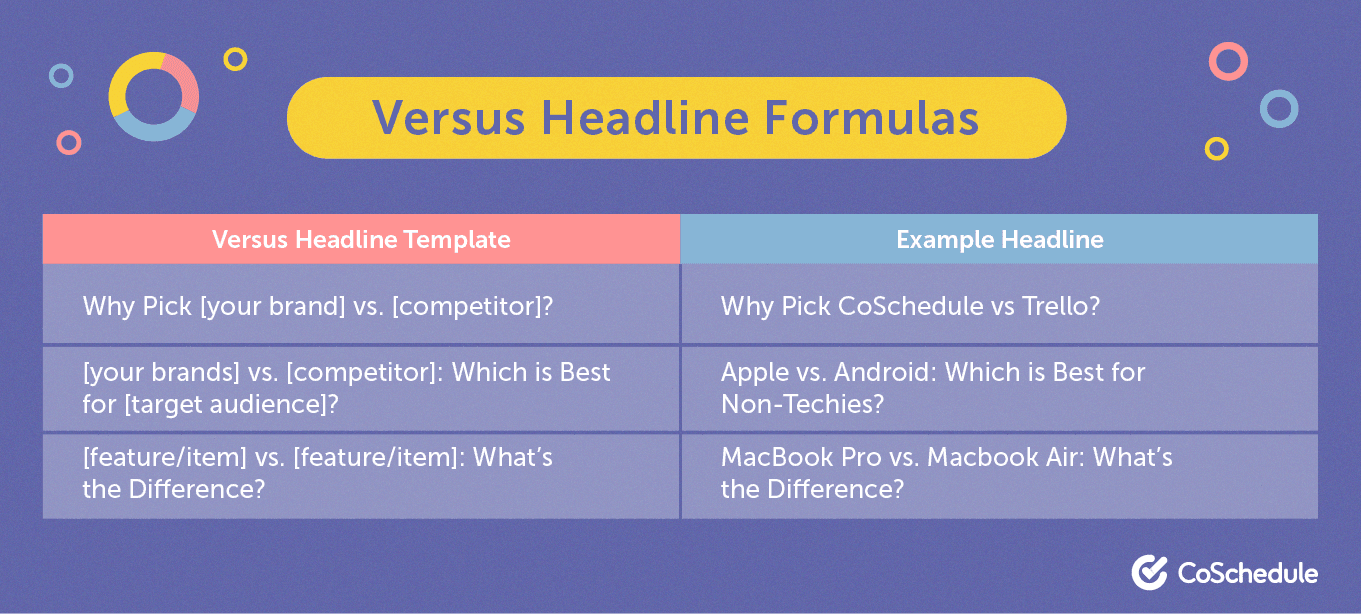
List Headline Formulas
Listicles are a round-up of tips or instructions. The goal is usually to teach the reader something or entertain them. It’s a top of the funnel content format that doesn’t need the reader to invest hours into reading.
That’s why your listicle headline needs to be spot-on. Thousands of marketers are writing listicles, often about the same topic. Your headline needs to stand out before anyone even lands on the page.
Here are some listicle headline examples for inspiration.
- The 9 Most Dog-friendly Countries in Europe: This is a simple example that shows listicle headlines don’t have to be complex. You can just offer what it says on the tin — like a round-up of the best dog-friendly countries.
- 20 Ways To Be Creative When You Don’t Feel Inspired: This headline example is a list of ways to be more creative, but they’ve added a smart tagline to the end that proves it’s more than the bog standard tips a competitor might offer. It’s the go-to resource for people who want to be creative, but feel like they can’t use traditional tips.
- Top 10 Features of a Profitable Rental Property: This blog post could’ve easily been titled “What to Look for in a Rental Property,” but they’ve turned the headline into a list-based title that acts as a checklist. It also uses a power word: “profitable.” You don’t just want any rental property; you want one that makes money.
- 12 Rules for Learning Foreign Languages in Record Time: This headline is great because instead of a tips or techniques format, it lists each step as a “rule,” which makes it much more interesting than a list of tips. There’s also the “record time” part at the end of the headline. This plays to a pain point their ideal reader has: the fact it takes a lot of time to learn a language.
- The 50 Best Movies on Netflix Right Now: The word “best” is a power word, but it can be overused. It’s also subjective — anyone can label something the “best” because it’s their opinion. However, we’ve included this example because of the “right now” add-on. It creates a sense of urgency. You want to click it now, rather than adding it to your bookmarks tab to read later.
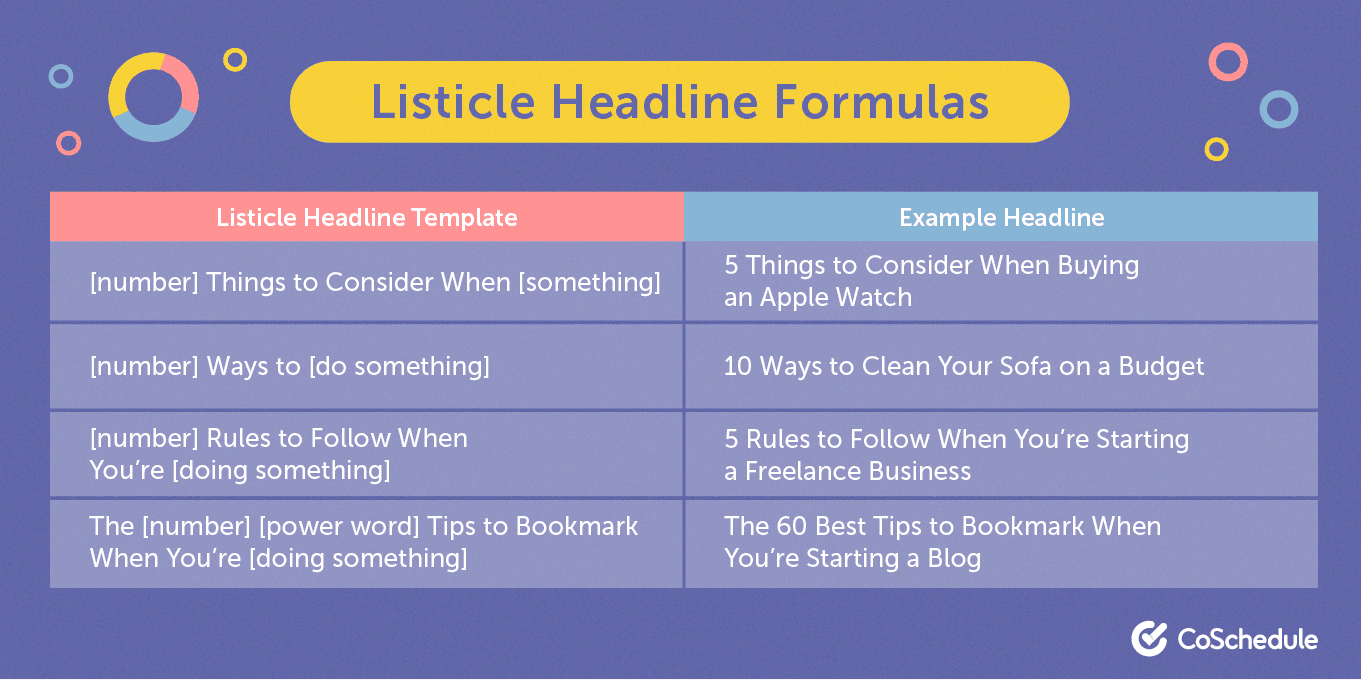
News Headline Formulas
News headlines are one of the hardest to write because they can massively vary.
Unlike a how-to blog post or listicle, you don’t know what you’ll be writing about. The news story itself isn’t always guaranteed to include something, making it tricky to write news headlines over and over again.
Plus, news headlines tend to be longer, specific, and attention-grabbing. Hundreds of publications likely report on the same news release. A smart headline can help yours stand out.
Let’s break down these three news headline examples.
- Coronavirus: UK-wide infections fall by up to 4% a day, but could be rising in London: This news headline starts by mentioning a popular topic. That grabs the reader’s attention straight away. It also goes on to share a statistic that shocks people, with a juxtaposition at the end calling out a local area.
- To cut LAPD’s budget by $150 million, reduce officer ranks below 10,000, report says: Here’s another news headline that leads with statistics. It works because people are becoming less trustworthy of news stories. The rise of fake news means people want to read true, reliable news. Including those statistics — that aren’t just opinions — proves that in the headline.
- Beyoncé releases surprise new song, “Black Parade,” on Juneteenth: This news headline is interesting because it has two concepts that work. First, it has the power word, “surprise,” in the middle that provokes emotion. Second, it includes the words people would search for if they wanted to read a news story about that topic: “Beyonce” and “Black Parade”.
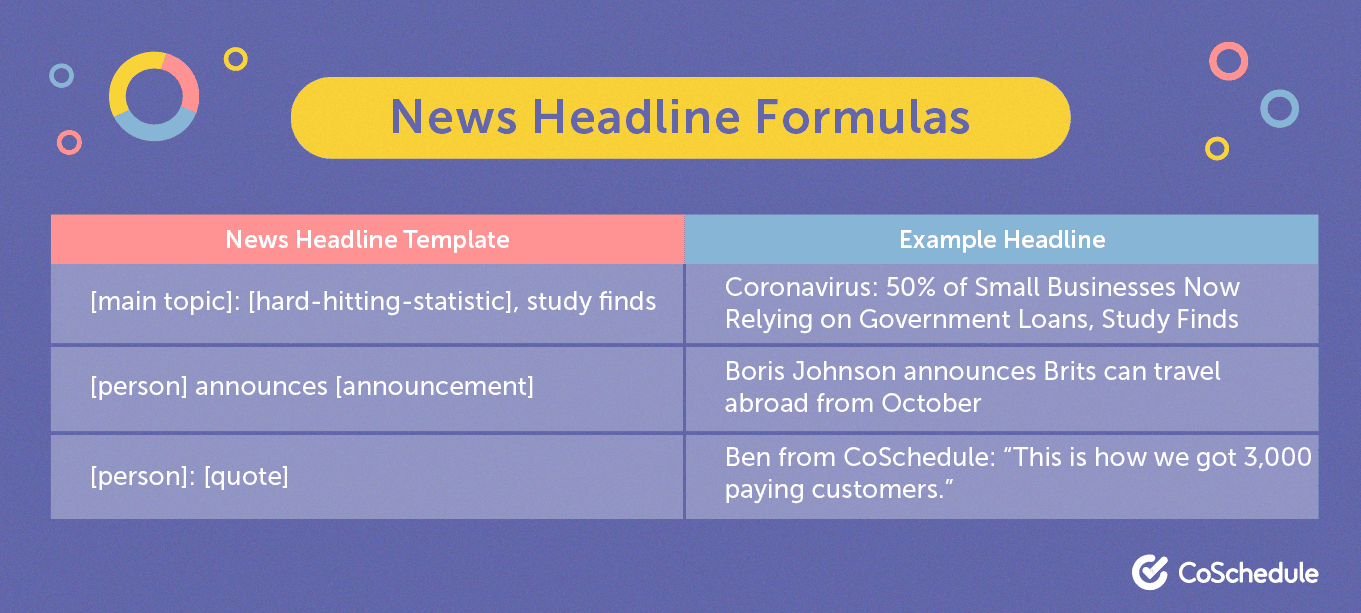
Positive Headline Formulas
Did you know that positive headlines do a better job at encouraging social shares?
That’s one of the goals of any headline. More social shares mean more eyeballs on your content, and if the headline is good, that means more traffic to your website.
The aim of a positive headline is to make people feel good when they read it, and entice them to read more to feel even happier.
Here are three great examples of how positivity can be added into a headline.
- The 30 Best Content Research Tips That Will Make You More Influential: An easy way to make your headline more positive is by adding a result that someone will get from clicking it. This one, for example, says the reader will become “more influential” if they click through. That’s a positive outcome, so people want to click-through and experience it themselves.
- 9 Subtle Signs That Your Dog Loves You: Emotional words like “love” get a positive response without much effort. This headline shows that in action. It’s short (eight words long), but makes you feel good.
- Surprising Percentage of People Feel Happier After Spontaneous Decisions: The word “surprising” gets this headline off to a strong start, but they’ve also used the word “happier” — an obvious way to make your headline more positive. It’s a great way to turn an ordinary statistic-related post into something more exciting.
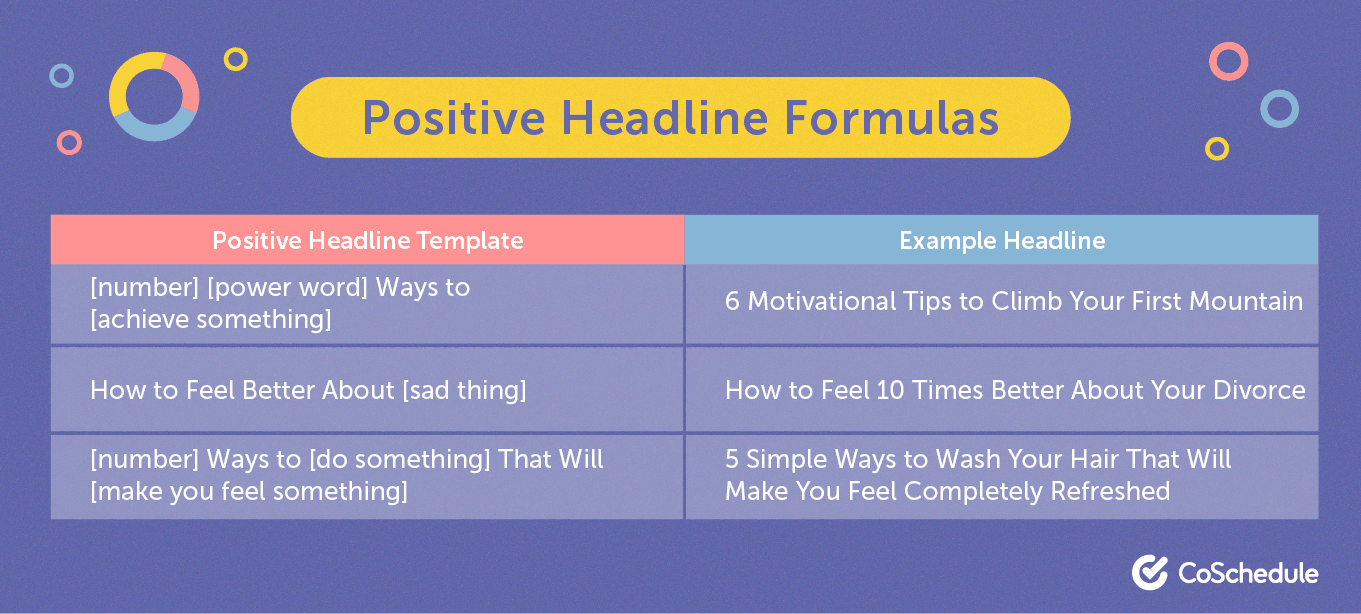
Negative Headline Formulas
We know that positive headlines make people feel happy. A negative headline does the opposite.
The point of a negative headline is to scare someone into reading it with powerful words, like “avoid,” “stop,” or “concerns.”
This type of headline is effective because it has a sense of urgency tied to it. You’re encouraging people to do something now to avoid something bad, and that they should click to read your content to prevent it.
Let’s look at four great negative headlines that do this well.
- Is FaceApp a Security Risk? 3 Privacy Concerns You Should Take Seriously: This headline uses a powerful negative word, “risk,” in the first half. It grabs your attention immediately, then follows up with the word “concerns”. Those two words alone are enough to scare you into clicking through.
- Public Speaking Is 10x Harder Online. These 4 Things Can Help: A negative headline doesn’t have to be scary. This example proves you can tap into a pain point to write your headline — such as public speaking online. It starts with a sentence that aggravates how you’re feeling and promises a solution at the end.
- The Most Complete Content Editing Process to Avoid Copy Disasters: A simple and effective way to create a negative headline is by adding the word “avoid” inside. Take your normal headline template, and imply that the reader should do it to avoid something else.
- How to Keep Your Smart TV From Spying on You: Nobody likes being spied on, so instead of going with a bog standard headline, like “How to Make Your TV More Secure,” they’re playing on a fear that most people have.
SEO Headline Formulas
Keywords are terms or phrases that people type into search engines. You’ll have a keyword for every piece of content you create — regardless of whether you know it or not.
An SEO headline is the title tag of your content. It’s the sentence that Google pulls when your website loads in a results page:
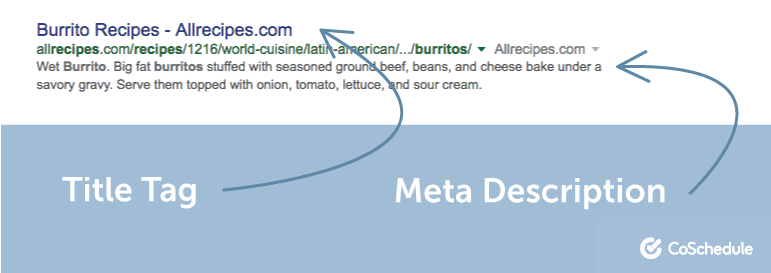
Your SEO headline is important here because research shows that including the keyword in the title tag impacts rankings. That means your content can be ranked higher up on a searcher’s results page, resulting in more people clicking through to your site.
Let’s take a look at how you can create an SEO headline that achieves this goal.
- What Are Mutual Funds? A Guide For New Investors: This SEO title starts with a question their audience will be searching for to find it. There’s a combination of keywords that correlate to what their readers might be searching for, too — such as “mutual funds guide” and “mutual funds for newbies”.
- Sprocker Spaniel Breed Information: Everything You Need to Know: This example has the same approach as above; it includes other related terms their reader will be searching. They can type “Sprocker Spaniel” or “what you need to know about Sprocker Spaniels”. The SEO title covers both.
- How to Use BuzzSumo: The Ultimate Guide on Uncovering Hot Topics to Create Content Your Audience Will Love: This has a popular how-to search term at the front, and goes on to explain what you’ll get by clicking the result. However, it is slightly longer than the 60 character limit of a title tag.

Shareable Social Media Headline Formulas
This headline combines a few of the other formulas we’ve already shared — particularly positive or negative, curiosity, and list-based headlines.
The goal is to write something people want to share with their friends. They’re usually news-related for this reason, but you can create a shareable headline for other types of content.
Let’s take a look at some examples.
- Cleaning and hygiene tips to help keep the COVID-19 virus out of your home: This post got more than 2 million social media shares partly because it jumped onto a current topic: coronavirus. They could’ve gone with something like “5 tips to keep your home clean,” but it uses the negative spin to intrigue people into clicking and sharing.
- PSA: ‘The Holiday’ Is Coming To Netflix Later This Month: This one got over 240 Facebook comments because people wanted to tag their friends to tell them about the news. It proves that people want to share news, and you should try to tie it into your headline.
- 5 Dangerous Webinar Mistakes (And How to Avoid Them): With more than 7.6K shares, this headline example also has a negative spin. It uses the word “dangerous” to get you hooked, then offers to share how you can avoid it by clicking through.
- The 31 Irrefutable Laws for Creating an SEO-Friendly Website That Ranks in Search. Here’s a great example of how B2B content can get 500+ shares with a strong headline. It uses power words, like “irrefutable,” and gets tons of SEO power. You can make a combination of popular search terms with the title, like “SEO-friendly website” and “how to make a website that ranks in search”.
- 12 K-Pop Songs That Got Slept On In 2019: With 9K shares, this one uses the curiosity format we discussed earlier. It suggests that you’re missing out on something — the FOMO tactic that triggers people into clicking to find out.
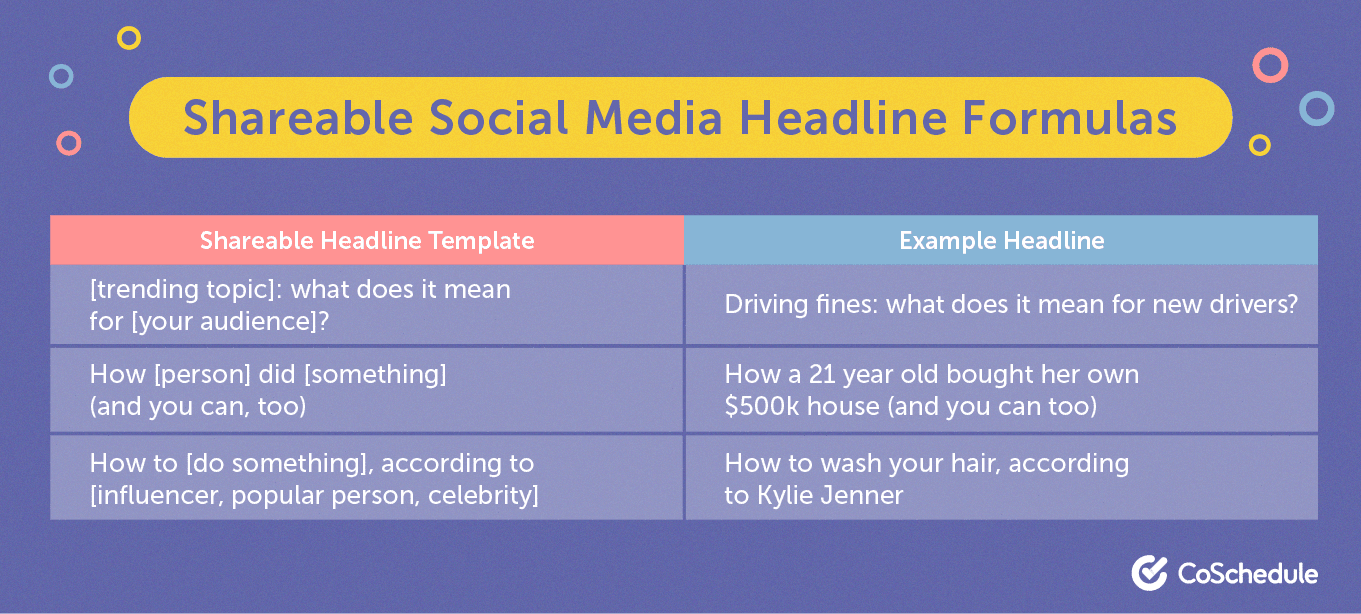
Email Headline and Subject Line Formulas
Headlines for public content are hard enough to write, but email subject lines are even harder to get right because you’re delivering them to a sacred place — their inbox. It’s not like social media, where readers go to be entertained. People check emails to find important information.
Any bad subject lines won’t get opened — making your entire email pointless.
Let’s break down why these email subject lines made me open them:
- “? NEW: MetaLab’s Case Study with Pitch” by Corey Haines: Emails are a crowded place, but a great way to stand out is by using emojis in your subject line, like this example shows. It breaks up walls of text and draws your attention to the image.
- “I should have spoken up sooner” by Paul Jarvis: This example follows the curiosity format we discussed earlier. It gives a strong statement, but you have no idea what it’s about. You need to open it to find out.
- “Why I specialize (and maybe you should, too?)” by Kaleigh Moore: Readers are selfish, and I say that in the nicest way possible. They want to read things they’re interested in. If they’re not, they just won’t open it. This example, from Kaleigh, starts by explaining why she does something and tags why her audience should, too. That gets them invested.
- “☕️C’mon, do something” by Morning Brew: Here’s another email subject line that uses emojis at the start, but what’s great is that this email replicates their reader’s language. Abbreviations, like “c’mon,” sound like a human is actually writing it. That personal connection is what people want in their inbox.
- “Revealed: the secret to a good credit score” by Clearscore: Here’s an example of a power word used well in an email subject line. It kicks off with the word “revealed,” which implies that it’ll show you something you didn’t already know. It also refers to the email content as a “secret,” and we all want to get in on them.
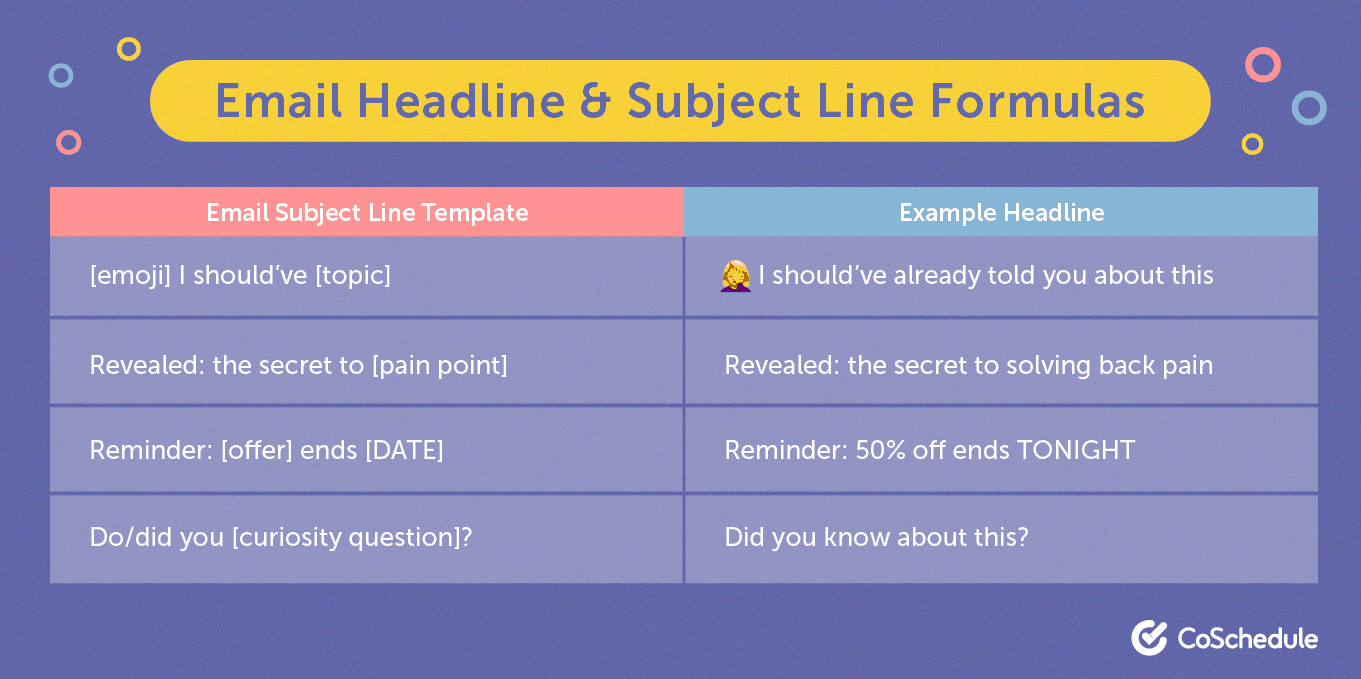
Landing Page Headline Formulas
A landing page is an informational page that talks about a product, service, or feature.
Because of this, landing pages usually have more purchase intent than a standard blog post or social media post. The goal is to make people scroll down, learn more about the thing you’re educating people about, and convert.
Here are some examples of landing page headlines to draw inspiration.
- A brand templating platform you and your brokers will love: It should be clear what the topic of your landing page is as soon as you arrive there. This headline does exactly that: it includes what the tool they’re promoting is and who uses it. The visitor can self-identify with it.
- Capture 3x More Leads by replacing your website’s forms with smart, interactive LeadForms: Including real, tangible results in your landing page headline helps get buy-in from the visitor immediately. This one shares how you can get three times more leads (i.e. the visitors’ pain point.) You want to scroll down to learn more.
- Everybody welcome at the UK’s favourite gym: Businesses try to win awards for one reason: they look great. If other people have voted them as the best, it builds more trust with their visitors. This headline shows how to do that for a landing page.
- Win more work with online estimates that give you the edge: Your landing pages shouldn’t just talk about the feature you’re promoting. It should explain why the reader needs it, too. This example shows how to position a target audience’s goal as the focus.
Advertising Headline Formulas
You’ll need to write a headline for any advertising copy you’re writing — whether that’s print, PPC, or social media ads.
However, you could argue that this type of headline is more important than any other. That’s because the goal of getting a click is more important with advertising headlines. You’re actually paying for it, and no clicks equals no return on your investment.
In short, a bad advertising headline could sabotage your entire campaign.
Let’s take a look at some real world examples that worked.
- Freshworks CRM vs The Others – Try The All-In-One CRM: When customers are searching for a product, they want to know that the brand they’re getting it from is the best option. This headline does that by comparing their tool to their competitors. It’s also interesting to note that this advertising headline doesn’t mention competitors. Instead, it refers to them as “the others,” which stops them infringing on a trademark that could shut their ad down.
- SEMrush SEO Tool – Want To Save Time on SEO?: This advertising headline has the brand name at the front to build brand recognition. It also clearly shows that they’re promoting an SEO tool and ends with a question that relates to their audience’s pain point, which is saving time.
- $0 Delivery Fee for Your First Month: Any customer, buying any product, will have objections before they click an advert and buy something. The most common are price-related. This advertising headline covers that, and actually gives them an incentive to buy with no delivery fees.
- With one million workouts to choose from, we aren’t kidding when we say we have something for everyone: While this is a long advertising headline, it works because it shows how broad ClassPass’s exercise library is. Their customer’s pain point might be related to finding a class that works for their fitness level. This solves that immediately.
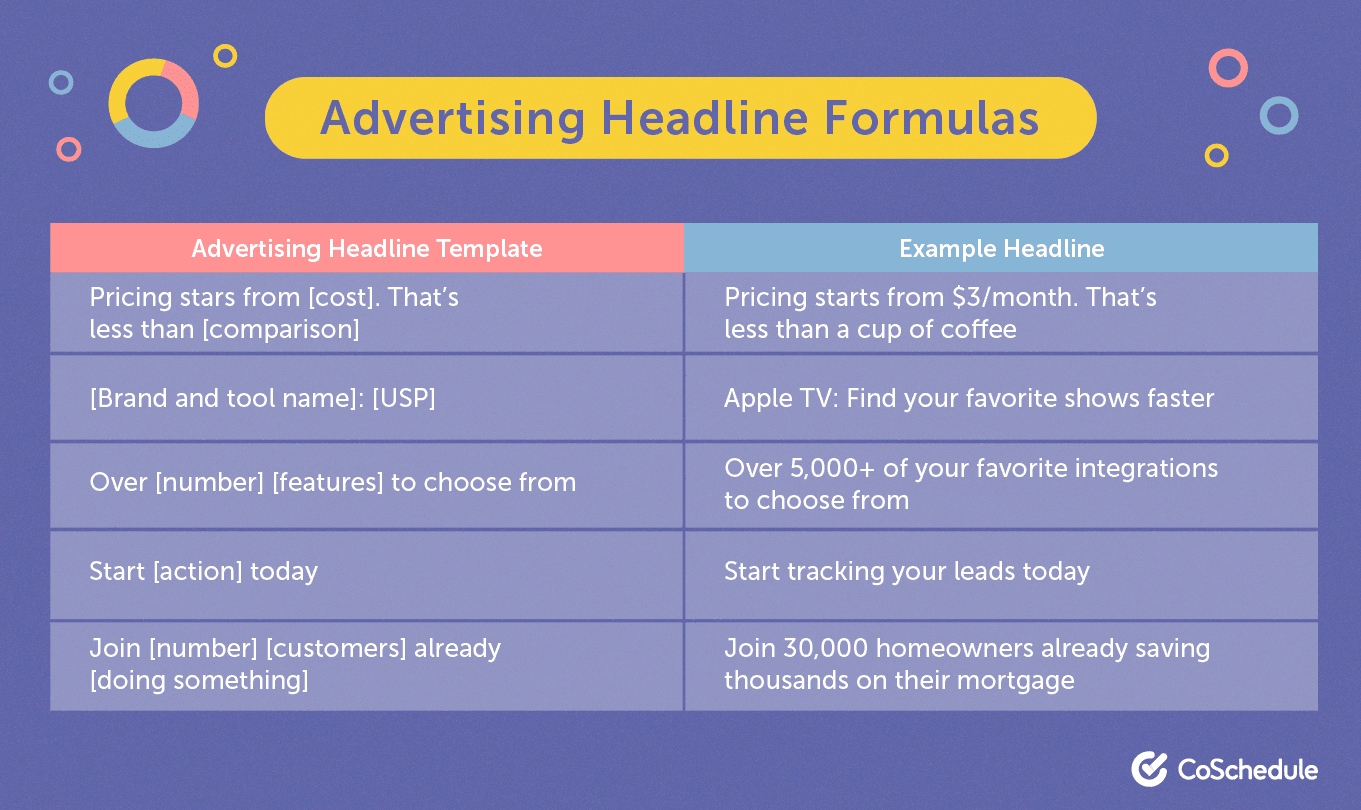
Master Your Next Headline With These Formulas
With this master list of headline templates, there’s no excuse to skip past the headline part of your marketing content. It’s the most important part; it needs special attention.
That’s why we’ve brought you an add-on tool to master your headlines: Headline Studio.
Headline Studio brings you millions of all-new, actionable suggestions that tell you exactly how to improve your headlines. Plug in these headline templates and tweak to your heart’s content, getting individual suggestions to get more clicks.
Recommended reading:


